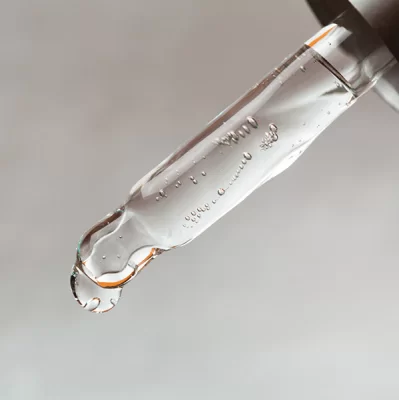Hyaluronic acid
- What is hyaluronic acid and what are its properties?
- What are the types of hyaluronic acid?
- What are the applications of hyaluronic acid in medicine and cosmetology?
- How to correctly use cosmetics with hyaluronic acid?
- What are hyaluronic acid treatments in aesthetic medicine based on?
- Is hyaluronic acid supplementation effective?
- What are the contraindications for using hyaluronic acid and possible side effects?
Hyaluronic acid is a natural biopolymer and polysaccharide present in the body. It is a key component of the skin, connective tissue, and synovial fluid, where it works alongside collagen and elastin.
Its remarkable feature is its ability to bind water, making it a powerful humectant. Hyaluronic acid:
- intensely moisturizes the skin,
- improves skin density, smoothness, firmness, and elasticity,
- has anti-aging properties, firming the skin and visibly reducing wrinkles,
- acts as an anti-inflammatory and antioxidant,
- creates a protective barrier on the skin,
- supports skin regeneration and speeds up wound healing.
Its natural origin and biocompatibility make it a valuable and safe ingredient in cosmetics.
Hyaluronic acid occurs in several variants, which differ mainly in molecular weight and chemical structure. Due to the size of molecules, several basic forms of hyaluronic acid are distinguished:
- high molecular weight forms, which create a protective barrier on the skin surface, effectively preventing water loss,
- medium molecular weight forms, which penetrate deeper due to smaller sizes, providing intense hydration to the skin,
- low molecular weight and ultra-low molecular weight forms, which act regeneratively from the inside,
- triple hyaluronic acid, a combination of different molecule sizes, ensuring comprehensive action and optimal absorption by the skin.
Another division, based on chemical structure, allows distinguishing further variants of this ingredient. Non-crosslinked hyaluronic acid, with a looser structure, is used in mesotherapy and cosmetic products. Partially crosslinked and fully crosslinked forms are much more durable - they are mainly used as fillers in aesthetic medicine procedures.
In cosmetic products, we often encounter derivatives of hyaluronic acid, such as sodium hyaluronate, potassium hyaluronate, hydrolyzed hyaluronic acid, or acetylated sodium hyaluronate.
Hyaluronic acid is a versatile substance, valued for its ability to bind water, anti-inflammatory, and regenerative properties. It is widely used in medicine and cosmetology.
In cosmetics, hyaluronic acid is a key ingredient in creams and serums. The main effects of its action are:
- intensive moisturizing and firming of the skin,
- strong skin regeneration,
- acceleration of wound healing,
- alleviation of inflammatory conditions,
- reduction of micro-damage to the epidermis.
In medicine, its applications include:
- treatment of joint diseases (orthopedics),
- moisturizing dry eyes (ophthalmology),
- fighting intimate infections (gynecology),
- support for anal disorders (proctology),
- therapy for periodontal diseases (dentistry),
- regeneration of vocal cords.
Cosmetics with hyaluronic acid, most commonly available as serums or elixirs, require proper application for maximum effectiveness. To fully harness their potential, apply them to slightly damp skin, preferably after using a toner. This will allow the acid to be better absorbed and retain water, significantly increasing its moisturizing effect. Then, to retain moisture in the epidermis and strengthen the skin's protective barrier, apply your favorite cream. It will create an occlusive layer that effectively prevents moisture loss.
Hyaluronic acid is a versatile ingredient suitable for all skin types, including sensitive, combination, oily, and acne-prone skin. It is also exceptionally safe to use in combination with other active ingredients. You can confidently use it together with:
- vitamin C,
- niacinamide,
- retinol,
- panthenol,
- AHA acids,
- BHA acids.
If you are interested in creating your own cosmetics, hyaluronic acid in powder form serves as an excellent base for them. You can precisely tailor such a product to meet the individual needs of your skin.
In aesthetic medicine, hyaluronic acid is widely used due to its versatility. Depending on the degree of cross-linking, it serves various functions. Cross-linked hyaluronic acid acts as an effective filler, helping to reduce wrinkles and fill in grooves, such as nasolabial folds. It also excellently sculpts facial contours, restoring lost volume, especially in the cheek area. Non-cross-linked hyaluronic acid is used in mesotherapy procedures.
Specific treatments with hyaluronic acid are also popular, such as lip augmentation or tear trough correction. Needle mesotherapy, using non-cross-linked hyaluronic acid, is a way to moisturize and revitalize the skin. All these procedures are performed by experienced doctors or cosmetologists, often using local anesthesia for maximum patient comfort. The effects are usually immediately visible: the skin looks younger, significantly refreshed, and gains healthy volume.
Numerous studies confirm that hyaluronic acid taken orally is effective. Taking it regularly significantly improves the condition of the skin, increasing its hydration and elasticity. Supplementing with this ingredient also supports joint health, providing better moisture and increased mobility.
After consumption, hyaluronic acid breaks down into smaller metabolites. The body effectively absorbs them and then uses them to build its own tissues.
When choosing a hyaluronic acid supplement, always be cautious. Make sure to check the dose of the acid and its molecular weight. Ensure that its effectiveness has been confirmed by reliable studies.
Cosmetics with hyaluronic acid are usually safe and rarely cause allergic reactions. However, in the case of injectable procedures, there are certain contraindications, which include:
- pregnancy,
- breastfeeding,
- autoimmune diseases,
- active skin infections,
- tumors.
After procedures with hyaluronic acid, mild adverse reactions may occur, which usually resolve spontaneously within a few days. These include:
- pain,
- burning,
- itching,
- swelling,
- redness,
- bruising at the injection site.
Serious complications are rare, and if needed, the administered product can be quickly dissolved using hyaluronidase enzyme. Importantly, the recovery period after procedures with hyaluronic acid is very short, and this component does not cause sun sensitivity.

